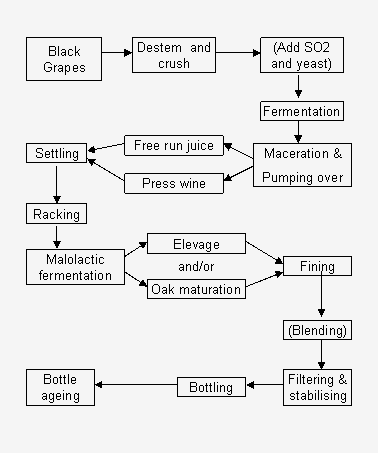![]()
![]()
![]()
Wine is more than just grapes.
It's all very well knowing where a wine comes from and even who made and what their philosophy of life is. But if you have a grasp on the basics of how a wine is made, then you will have a better understanding of the wine itself and why it tastes as it does.
Grapes are picked when they are ripe - when the sugar and acid levels are correct. The stemmer / crusher removes the stalks from the bunches and then roughly crushes the grapes to allow fermentation to begin.
Yeast may be added to kick-start fermentation.
During fermentation yeast turns the sugar in the must to carbon dioxide and alcohol.
Maceration is the period for which the juice is mixed with the solids to pick up flavour and colour and tannins.
Pumping over aids this process by pushing the liquid over and through the solids that float on the top.
The best quality wine is made from that which runs freely from the tank. The remaining must is pressed to extract the 'press' wine. The free run juice and the press wine are then blended |
|
and allowed to settle. The wine is then 'racked' or pumped off the solids that have settled into a new vessel. Malolactic fermentation is started (usually by inoculation) to turn tart malic acid into softer lactic acid by bacterial action.
The wine is then matured for a period (of great variation), sometimes in oak barrels to add a range of flavours and to develop the wine.
The wine is then fined. This is a process that removes any proteins or other substances that may leave the wine cloudy.
The wine is filtered to remove any remaining fining agents or lees that may have developed during maturation.
Bottling then occurs in the absence of air to avoid oxidation. Some wines may then be stored in bottle for several years before release to develop further.
There are myriad variations to this basic process at almost every single phase of production, and that is what makes wine so fascinating.
It is really very similar to red wine making, but the crucial difference is that the juice is pressed off the skins before fermentation rather than afterwards, and there is very little or no maceration on the skins.
Grapes are picked at full physiological ripeness (where possible) as dictated by sugar and acid levels.
The berries are destemmed and crushed and sulphur dioxide is added to retain freshness and prevent oxidation of the must (juice and skin mixture).
The free-run juice is collected and the remaining must is pressed gently to extract as much juice as possible, but avoiding pressing the pips which leave a bitter flavour.
The juice is treated with more SO2 and chilled and allowed to settle so the gross lees fall to the bottom. It is then racked off the lees and yeast is added and it is placed either in an inert vessel such as stainless steel tanks or into oak barrels for fermentation. Oak barrels will impart vanillary, toffee flavours, but stainless steel will retain the freshness of the fruit.
Malolactic fermentation is started (usually by inoculation) to turn tart malic acid into softer lactic acid by bacterial action.
In some wines the residue from fermentation is left in the vessel and periodically stirred through the wine to increase body and flavour.
The wine is then racked off its lees into another vessel. At this stage blending may take place if required.
The wine is then fined to remove any proteins or yeast particles and tartrate stabilised.
Finally the wine is filtered to remove any remaining unwanted particles to ensure the wine is clean and bright.
Bottling occurs in the absence of air to prevent oxidation, and then some wines are bottle aged before release. |
Essentially sparkling wines undergo two fermentations, the second fermentation is in an enclosed environment so that the carbon dioxide given off during the second fermentation is unable to escape and under pressure dissolves into the wine.
This is achieved in several possible ways, the most costly and time-consuming of which is the traditional Method Champenois, used for Champagne and other high quality wines. The second fermentation happens in the bottle and then, after a period of maturation, the lees residue from the fermentation is slowly moved into the neck of the bottle (riddling) which is then briefly frozen so the lees can be disgorged. The bottle is then topped up with a mixture of sugar and grape spirit or reserve wine and then corked.
With the Transfer method, the wine undergoes its second |
|
| fermentation in bottle but after lees ageing, the contents are then transferred, under pressure, to a tank where the lees are removed by filtration and clarification. The wine is then given its dosage before being bottled under pressure and corked. These wines can show many of the quality characteristics of Champagne.
The Charmat method is much cheaper, faster and less labour intensive, but the result is not suitable for ageing, nor does it produce high quality wines. The base wine is held in a pressurised tank and after a rapid fermentation the wine is cooled to -5C. The result is filtered and clarified and the dosage added before bottling under pressure. These wines tend to taste more like sparkling wines with bubbles than having characteristic depth of flavour from fermentation in bottle. |
|
execellars |
